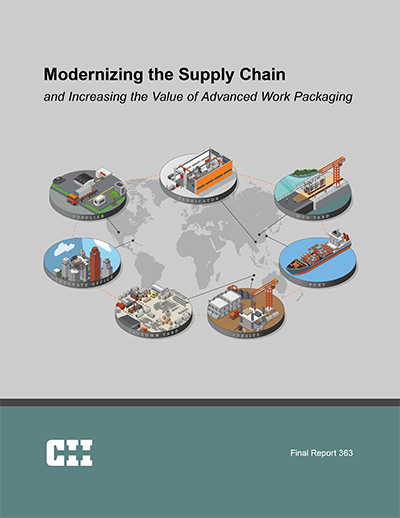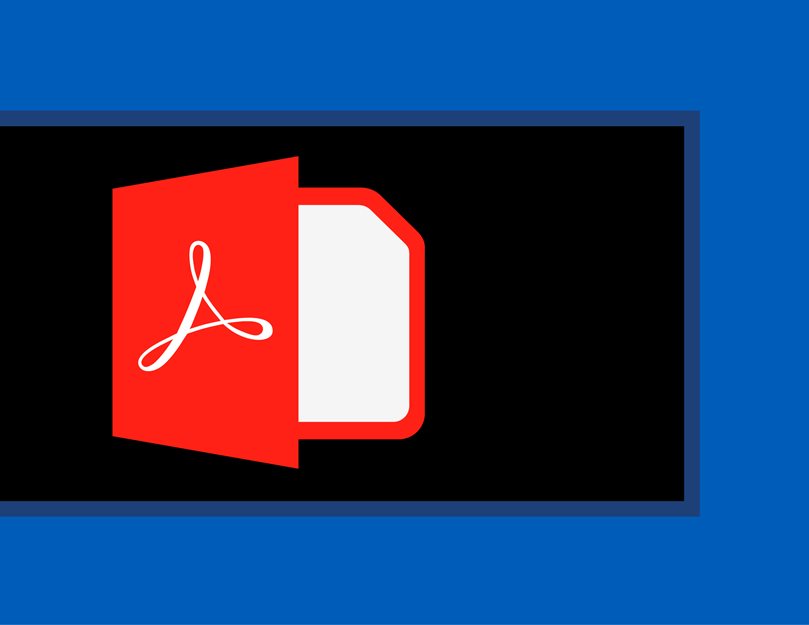
Modernizing the Supply Chain and Increasing the Value of AWP
CII chartered Research Team 363 (RT-363), Integrating the Supply Chain with AWP Practices, to conduct this research with the specific objective of enhancing Advanced Work Packaging (AWP) processes with respect to procurement and supply chain. The following chapters offer many specific recommendations with respect to AWP processes. RT-363 also defined a supply chain process and a Procurement Work Package (PWP) for use within AWP execution. A project team could benefit from following these recommendations even if it did not use AWP. Also, while the research team conducted this research primarily in the industrial sector, it expects these findings will be relevant to other sectors with substantial production in the supply chain.
The members of RT-363 consider improving supply chain performance to be an important pathway to increasing project productivity and predictability, and the findings of this research support the all-too-common stories of supply chain problems, such as late and out-of-sequence deliveries with consequent impacts on performance. However, the findings also suggest that these problems have actionable remedies.
The principal recommendations of this project fall under three areas:
- Improving the quality of orders to suppliers could be a major industry opportunity and low-hanging fruit. Areas for attention include clarity of scope, timeliness of orders, clear priorities for delivery, and delineation of needed information.
- Involving suppliers earlier in the project better leverages their capabilities and ensures timely delivery. All stakeholders broadly agree that there are opportunities for improvement with a range of benefits. An ancillary recommendation is to keep abreast of supplier capabilities at the corporate level, to make this information available to the project at inception.
- Improving information systems would assure the smooth exchange of information across the supply chain, supporting better and more timely decisions. The recommendations made in this report promote actualizing ideal materials management system capabilities that complement contemporaneous CII research on digital threads for AWP. As a related recommendation, the team proposes establishing the role of a Digital Supply Chain Coordinator to help set up and assure communication across disparate information systems.
RT-363 finds great opportunity in these recommendations. It is difficult for any project to be successful if the flow of materials is disrupted. These research findings show broad agreement among owners, engineers, contractors, and suppliers. Common issues in customer orders cause problems with supplying materials in a timely and cost-effective manner, and all stakeholder groups studied agreed that there would be significant benefits if suppliers were more involved on projects.
Suppliers can enhance projects in a number of ways, including the use of alternate technologies, value added delivery via kitting, and decreased production costs. One anecdote that stuck with the research team told of an instance where, if pipe-bending technology had been used, a project could have saved 10% of the cost of the order. Unfortunately, the project team placed its order too late to allow that option. Every supplier interviewed during this research, from high-value engineering to distributors, shared similar examples of missed opportunities for cost-saving efficiencies due to late contact with projects
Suppliers can be better involved in the project, especially if they are engaged earlier than has been usual practice. RT-363’s interviews with suppliers identified a number of opportunities for them to add to the project through earlier involvement. The team’s survey expanded on the results from the interviews and found that many challenges stemmed from late involvement of suppliers and that many benefits could be realized by involving suppliers earlier (FR-363, p. 24).
RT-363 promoted the Supply Chain Process (SCPr) as an enhancement to the original AWP documentation developed by RT-272.
AWP execution requires the capability to manage sourcing, logistics, delivery and receiving, and materials storage before installation – all at a level of detail that supports mapping information and materials to EWPs, CWPs, IWPs, and SWPs. Supply chain process capabilities must include the ability to source and track information deliverables as well as materials that support the planned execution sequence. Systems must support the ability to match the components of purchase orders (POs) with multiple EWPs, CWPs, IWPs, and SWPs. Procurement capabilities must also support work package level constraint management and materials allocation (FR-363, p. 34).
RT-363 described 20 changes to the work processes in the AWP Process Integration Flowcharts (a.k.a. swimlane diagrams) published in Volume II of IR272-2. These changes included updates to early planning, such as enhancements to supplier prequalification and supplier technology screening; developing a materials responsibility matrix and managing it through engineering and construction; and additional steps in materials tracking and materials readiness to support field activities (FR-363, Chapter 5).
RT-363 considers current materials management systems to be less than ideal, whether developed in house or commercially acquired. By drawing upon research findings from its interviews and survey, the research team identified the key capabilities for a materials management system. Practitioners can use these areas to audit existing tools and plan for logical expansions (FR-363, p. 60).
In addition to identifying processes and tools that could be key enhancements for supply chain performance, RT-363 acknowledged the importance of people to make the process and technology work. The team defined roles that would be required to enact the process improvements it had identified to enhance the AWP swimlanes (see Key Finding 3), and it wrote abbreviated job descriptions for them.
Key among these roles, the Digital Supply Chain (DSC) Coordinator would be involved early in the project to help design and to coordinate the transfer of information among stakeholders on the project. This role could expand beyond the supply chain function, but the team considered it to be critical to the successful communication of information across the supply chain (FR-363, p. 70).
RT-363 defined the Procurement Work Package (PWP) as an optional construct that some firms and projects may use as a mechanism to support the AWP execution program and the SCPr. AWP execution does not require a PWP.
If deployed, a PWP must support the capabilities described for the SCPr. For consistency with AWP definitions of work packages, a CWP may contain one or more PWPs, and PWP boundaries align with CWP boundaries. The set of PWPs that belong to a CWP describes all materials and related procurements that belong to that CWP. Procurements related solely to startup activities may be mapped against SWPs rather than CWPs. (FR-363, p. 34).


